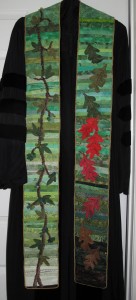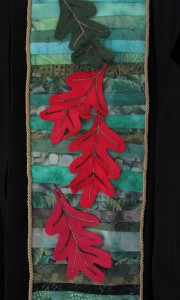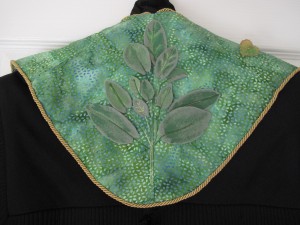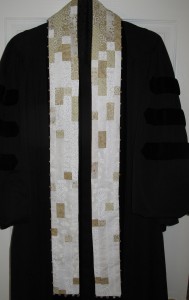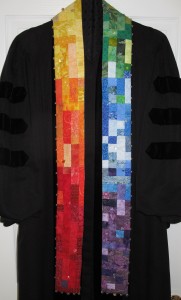This section contains images of stoles
I have designed and created for colleagues.
If there is something that intrigues you or sparks an idea,
I am available for commissions.
[Note: clicking on any photo will enlarge it.]
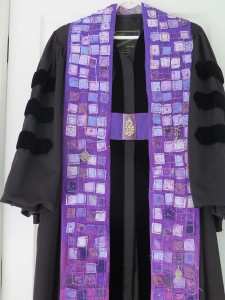 This is a Lenten stole, created using a ‘netting’ technique I explored during my 21-Day Art Journey-Exploration. The front side is hand-painted fabric, running from a light purple at the bottom to dark purple at the top. The small squares used in the netting start with the darkest at the bottom and transition to light near the neckline. Several different crosses are scattered across the stole. The reverse is a purple and green patterned fabric with a simple ribbon and beading embellishment.
This is a Lenten stole, created using a ‘netting’ technique I explored during my 21-Day Art Journey-Exploration. The front side is hand-painted fabric, running from a light purple at the bottom to dark purple at the top. The small squares used in the netting start with the darkest at the bottom and transition to light near the neckline. Several different crosses are scattered across the stole. The reverse is a purple and green patterned fabric with a simple ribbon and beading embellishment.
Spiritually, I sought to convey the sense of being both broken and whole, both separate and connected. I wanted to invite those who see the stole to wonder about the beauty and integrity of pieces as their own reality, not merely as part of something bigger.
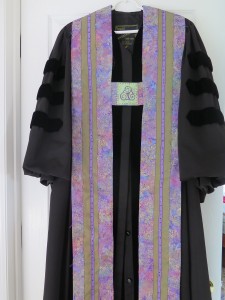 The reverse of the Lenten stole is a simple green and purple batik with superimposed ribbon and hand-beading. It could be used on the bridge Sundays into Lent or during the long Season of Pentecost.
The reverse of the Lenten stole is a simple green and purple batik with superimposed ribbon and hand-beading. It could be used on the bridge Sundays into Lent or during the long Season of Pentecost.
This stole has been made with a bar to fall at the solar plexus and to keep the stole from shifting during worship.
This stole was created for my husband’s 60th birthday. It reflects on growing into the autumn quarter of life. The yoke depicts the herb sage. The left panel (as you look at the wearer) is ivy, representing steadfast faith. The right panel is oak leaves, changing through the colors of fall. Oak is one of the nine sacred trees, most revered by the ancient Irish and used to mark holy circles.
The stole is made of narrow strips of cotton (mostly batiks). The sage and oak leaves are wool felt, cut, oversewn, and painted. The oak leaves are wired so that they change shape as they are worn. The ivy is beaded and hand-embroidered to add texture.
This reversible stole was made for the recent ordination of a colleague. Her work is with an urban congregation that includes not only young professionals, but street people. For that reason, all of the pieces used are small scraps that would otherwise have been discarded from larger projects — a reflection of the importance of every atom of creation (including the human beings we marginalize or otherwise disregard).
The rainbow represents the promise of God to all creation following the “second birth” in the floodwaters. The white and gold side is for high holy days, eucharist, baptism, and weddings.
